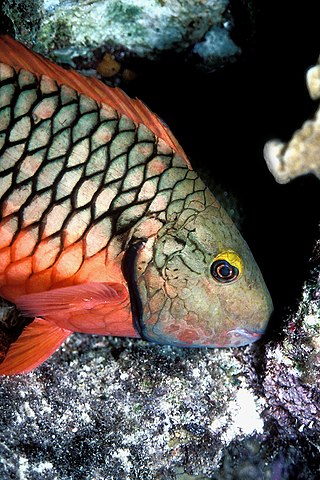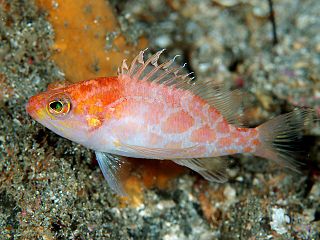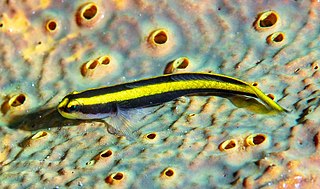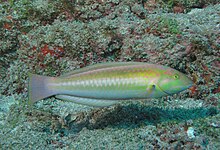
The Saint Peter and Saint Paul Archipelago is a group of 15 small islets and rocks in the central equatorial Atlantic Ocean. It lies in the Intertropical Convergence Zone, a region of the Atlantic characterized by low average winds punctuated with local thunderstorms. It lies approximately 510 nmi from the nearest point of mainland South America ; 625 km (388 mi) northeast of the archipelago of Fernando de Noronha; 990 km (620 mi) from the city of Natal; and 1,824 km (1,133 mi) from the west coast of Africa. Administratively, the archipelago belongs to Brazil and is part of the special "state district" of Fernando de Noronha, in the state of Pernambuco, in spite of the very large distance between the two island groups and the even larger distance to the state mainland.

Sparisoma is a genus of parrotfishes native to warmer parts of the Atlantic. FishBase recognizes 15 species in this genus, including S. rocha described from Trindade Island in 2010 and S. choati described from the East Atlantic in 2012. They are the most important grazers of algae in the Caribbean Sea, especially since sea urchins, especially Diadema, the other prominent consumers of algae, have been reduced in many places by a recent epidemic.

Plectranthias is a genus of ray-finned fish in the subfamily Anthiinae, part of the family Serranidae, the groupers and sea basses. They are found in the Atlantic, Indian and Pacific Ocean.

The slippery dick is a species of wrasse native to shallow, tropical waters of the western Atlantic Ocean.

The puddingwife wrasse, Halichoeres radiatus, is a species of wrasse native to the western Atlantic Ocean from North Carolina to Bermuda, through the West Indies and Gulf of Mexico, to offshore islands of Brazil, being absent from Brazilian coastal waters. It can be found on reefs at depths from 2 to 55 m, with younger fish up to subadults being found in much shallower waters from 1 to 5 m. This species can reach 51 cm (20 in) in total length, though most do not exceed 40 cm (16 in). This species is of minor importance to local commercial fisheries and can be found in the aquarium trade.

Halichoeres, commonly called wrasses, are a genus of fishes in the family Labridae found in the Atlantic, Indian and Pacific Oceans.

Potamarius is a genus of sea catfishes. The three species in this genus exclusively inhabit fresh water in southern Mexico and Guatemala. The individual species have relatively small ranges. The highly endangered Paragenidens grandoculis of Brazil was long classified in Potamarius, but a 2019 study has found it to belong in its own genus.

Hypleurochilus is a genus of combtooth blennies found throughout the Atlantic Ocean.

Halichoeres maculipinna, the clown wrasse, is a species of tropical fish that lives throughout the Caribbean Sea and adjacent parts of the western Atlantic Ocean. It is a carnivorous, multi-colored wrasse that is common throughout its range.

Luiz Alves Rocha is the Curator and Follett Chair of Ichthyology at the California Academy of Sciences. He is also an adjunct professor at the University of California Santa Cruz and San Francisco State University.

The blackear wrasse is a species of wrasse, a type of fish in the family Labridae, from the warmer waters of the western Atlantic Ocean.

Tosanoides aphrodite, the Aphrodite anthias, is a species of marine ray-finned fish, from the subfamily Anthiinae part of the family Serranidae, the groupers and sea basses. It was discovered in the Atlantic Ocean in 2018, the only one in its genus to be discovered there. It was first identified by Luiz A. Rocha and Hudson Pinheiro, staff members of the California Academy of Sciences. The fish is electric pink and yellow and has bright green fins. It was discovered near Brazil and can be distinguished by 15-16 soft dorsal fin rays and 9 anal fin rays. They are sexually dichromatic, meaning the males and females are different colors. It is named after Aphrodite, the Greek goddess of love and beauty. This species was found on mesophotic coral ecosystems of the Saint Paul's Rocks. They like to live in small spaces in rocky reefs. Also, they tend to live in areas between 13 and 15 degrees Celsius. Along with differences in body proportions, morphology of rays, distribution separates this genus from others that have previously existed.
Hypleurochilus brasil is a species of combtooth blenny from the subfamily Salarinae of the family Blenniidae. It is endemic to the reefs around Trindade and Martin Vaz off Brazil in the western South Atlantic Ocean.
Paragenidens is a monotypic genus of sea catfishes containing just one species, Paragenidens grandoculis. This species was formerly classified under the genus Potamarius until a 2019 study found it to be wholly distinct from it. It is endemic to Brazil, where it is known from the Doce and the Paraíba do Sul rivers and their mouths. It is highly endangered and was not seen for over 50 years until it was rediscovered during fieldwork for the 2019 study that reclassified it. It is now only known from Lagoa Nova in the municipality of Linhares in Espirito Santo state, having been extirpated from its only other recent locality, Lagoa Juparanã in Linhares.

Cirrhilabrus wakanda, the Vibranium fairy wrasse, is a species of fairy wrasse from the Western Indian Ocean. The species shares a combination of characters including short pelvic fins, and unmarked anal and dorsal fins. It was first collected off the coast of Zanzibar, Tanzania at depths of more than 60 meters by scientists from the California Academy of Sciences. It inhabits coral reefs.

Sparisoma rocha is a species of parrotfish endemic to the islands of Trindade and Martin Vaz in southeastern Brazil. The species can be distinguished from its congeners easily by its coloration. S. rocha is a herbivore, grazing on algae that grows on rocks or coralline substrate.

Elacatinus pridisi is a species of goby endemic to the islands of Trindade and Martin Vaz and the seamounts associated to these islands in Brazil. Like other species of the genus Elacatinus, it engages in cleaning behavior. However, unlike other cleaners, it lives in association with both sponges and Montastrea cavernosa instead of only coral. It was also recorded in association with sea urchins.

Halichoeres burekae, the Mardi Gras wrasse, is a species of wrasse native to the Gulf of Mexico. The species was first described from the Flower Garden Banks National Marine Sanctuary, in the northwestern Gulf of Mexico, but has since been recorded in other areas of the southern Gulf of Mexico. Because it is a small species that feeds on plankton in the water column, it is likely a preferred prey for invasive Lionfish. It also has a very restricted range, and corresponding relatively small population, what resulted in this species being listed as Endangered in the IUCN Red List.

Halichoeres sazimai, Sazima's wrasse, is a species of fish in the family Labridae found in deeper (20m+) and cooler waters off southeastern Brazil. It's closely related to the north Atlantic species Halichoeres bathyphillus, but DNA evidence shows they are different. They are often found in small groups of 5-10 individuals around rocky reefs.

Cirrhilabrus earlei is a species of fairy wrasse. They occur in the Western Central Pacific, Palau and Micronesia. In 2001 John Randall and Richard Pyle officially documented and described the species. Cirrhilabrus earlei is the known to the twilight reefs of Palau and the Majuro Atoll in the Marshall Islands. They live under depth range of 60–92 m, and its length is 6.9 cm SL. Male Cirrhilabrus earlei are adorned with sword-shaped tails, the tiny female species are same as male stimulates the male into the nuptial.


















